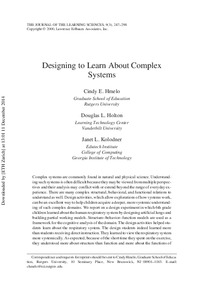 Zusammenfassungen
Zusammenfassungen
Complex systems are commonly found in natural and physical science. Understanding such systems is often difficult because they may be viewed from multiple perspectives and their analysis may conflict with or extend beyond the range of everyday experience. There are many complex structural, behavioral, and functional relations to understand as well. Design activities, which allow explorations of how systems work, can be an excellent way to help children acquire a deeper, more systemic understanding of such complex domains. We report on a design experiment in which 6th grade children learned about the human respiratory system by designing artificial lungs and building partial working models. Structure-behavior-function models are used as a framework for the cognitive analysis of the domain. The design activities helped students learn about the respiratory system. The design students indeed learned more than students receiving direct instruction. They learned to view the respiratory system more systemically. As expected, because of the short time they spent on the exercise, they understood more about structure than function and more about the functions of different parts of the respiratory system than its causal behaviors. This early Learning by Design experiment makes several important suggestions about successful learning from design activities: (a) the need to define design challenges functionally; (b) the importance of dynamic feedback; (c) the need for multiple iterations toward a solution; and most important; (d) thinking about design as a system of activities and allocating time so that the full system can be carried out, allowing its full set of affordances to be realized.
Von Cindy E. Hmelo, Douglas L. Holton, Janet L. Kolodner im Text Designing to Learn About Complex Systems  Dieser wissenschaftliche Zeitschriftenartikel erwähnt ...
Dieser wissenschaftliche Zeitschriftenartikel erwähnt ...
 Personen KB IB clear | H. Barrows , John Seely Brown , Ann L. Brown , Allan Collins , Sharon Derry , Yasmin B. Kafai , Susanne Lajoie , S. E. Newmann , Mitchel Resnick , R. Tamblyn | ||||||||||||||||||||||||||||||||||||||||||||||||||||||
 Begriffe KB IB clear |  Denken Denken thinking
, thinking
,  LehrerIn LehrerIn teacher
, teacher
,  Lernen Lernen learning
, problem-based learningproblem-based learning
, Systemsystem learning
, problem-based learningproblem-based learning
, Systemsystem
| ||||||||||||||||||||||||||||||||||||||||||||||||||||||
 Bücher |
| ||||||||||||||||||||||||||||||||||||||||||||||||||||||
 Texte |
|
 Dieser wissenschaftliche Zeitschriftenartikel erwähnt vermutlich nicht ...
Dieser wissenschaftliche Zeitschriftenartikel erwähnt vermutlich nicht ... 
 Nicht erwähnte Begriffe | Bildung, Kinder, Schule, Unterricht |
 Tagcloud
Tagcloud
 Zitationsgraph
Zitationsgraph
 Zitationsgraph (Beta-Test mit vis.js)
Zitationsgraph (Beta-Test mit vis.js)
 Zeitleiste
Zeitleiste
 2 Erwähnungen
2 Erwähnungen 
- How Kids Learn Engineering - The Cognitive Science Perspective (Christian D. Schunn)


- Machine Learning and the Five Big Ideas in AI (David Touretzky, Christina Gardner-McCune, Deborah Seehorn) (2022)



 Anderswo finden
Anderswo finden
 Volltext dieses Dokuments
Volltext dieses Dokuments
 |  Designing to Learn About Complex Systems: Artikel als Volltext ( Designing to Learn About Complex Systems: Artikel als Volltext ( : :  , 210 kByte; , 210 kByte;  : :  2021-03-21) 2021-03-21) |
 Anderswo suchen
Anderswo suchen 
 Beat und dieser wissenschaftliche Zeitschriftenartikel
Beat und dieser wissenschaftliche Zeitschriftenartikel
Beat hat Dieser wissenschaftliche Zeitschriftenartikel während seiner Zeit am Institut für Medien und Schule (IMS) ins Biblionetz aufgenommen. Beat besitzt kein physisches, aber ein digitales Exemplar. Eine digitale Version ist auf dem Internet verfügbar (s.o.). Es gibt bisher nur wenige Objekte im Biblionetz, die dieses Werk zitieren.

















 Biblionetz-History
Biblionetz-History